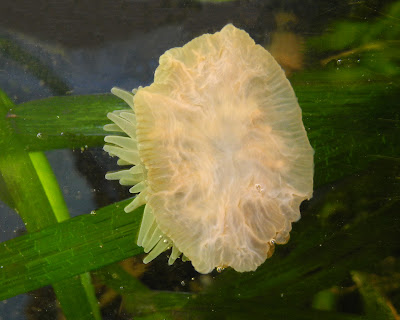Laurie keeps finding me bull kelp holdfasts, full of stranded critters. I can only bring so many home; there's not enough time to examine them all, nor can I save more than a few of the dispossessed. Last week, I picked two of the freshest (but they were already disintegrating in my hands) and brought them home to see who was still living there.
Worms, of course; the almost microscopic snaky threads; a few polychaetes, already dead, which I fed to the hermit crabs, a special treat; and a purple ribbon worm, Paranemertes peregrina.
 |
| The underside is a paler brownish colour. The worm was about 4 inches long, although he wasn't too enthusiastic about untangling himself to be measured. |
The species name, peregrina, means travelling, so this worm is also called the wandering worm, or the restless worm. It's a predator that wanders about hunting for smaller worms among rocks and mud.
There were several snails deep inside the maze, hard to dig out without dismantling the walls. A couple of dead barnacles. A very small clam, alive and active, now delving happily in my aquarium bottom. Circular patches of bryozoans. And amphipods, of several species; the common beach hoppers, squatters in the abandoned hallways, and some very large, brown amphipods, twice the size and more of the ones that live in the eelgrass.
And on the topside of one of the holdfasts, there were two fat, solid-looking, yellow, bagel-shaped things. Egg cases, probably, although it seems early for them. They were about 2 mm across. I left them in the aquarium while I tended to other things, then went back two days later to take their photos. Alas! All that was left was a large mass of transparent jelly, fraying and dissolving into the water even as I looked it over.
A couple of handfuls of eelgrass, roots and all, were more productive. On the blades themselves, I found many limpets, a couple of very small mussels (one survived), green amphipods, bryozoans and just a few little containers that seemed to be holding eggs.
I always check eelgrass roots for skeleton shrimp. There are usually a few, even in winter; this time, they included the largest one I have ever seen. They grow up to about an inch and a half; this one was half that.
 |
| A female, carrying young in her green brood pouches. |
Anemones, when they don't approve of their surroundings, often up anchor and slide or even float away. My burrowing anemone has worked her way about a foot along the floor of the aquarium to a spot she likes. Other anemones just let the water carry them whither it will. So when I found three small, green anemones, probably the orange-striped anemone, in the bag of eelgrass and holdfasts, I couldn't be sure where they had been attached. These do like the upper intertidal zone, so they were probably on the eelgrass.
 |
| Bottom disc. The orange striping is visible. About half an inch across. |
The other two were much smaller, and have been eelgrass hopping, not yet finding blades to their taste. They will, but it has to be their decision; for critters without a brain, amazingly, they still manage to have their own ideas.



Wow - this is so cool. I have ocean envy every time I read your posts :-)
ReplyDelete